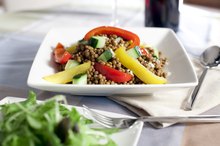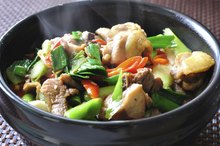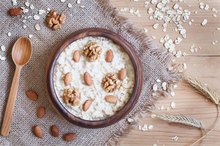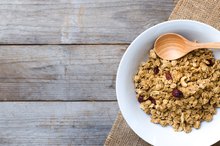Mayo Clinic 1,200-Calorie Diet
The U.S. News & World Report named the Mayo Clinic diet the third best overall weight management plan of 2014, based on the advice of health experts like Yale-Griffin Prevention Research Center director Dr. David Katz. Not to be confused with a Mayo Clinic diet circulated on the Internet that calls for daily cabbage soup or grapefruit, the official program endorsed by the clinic emphasizes healthy lifestyle changes geared to lead to sustainable weight loss. The 1,200-calorie version of the diet is designed for women, although a higher caloric intake may be needed if you are physically active. Ask your doctor or a dietitian for help determining how many calories you need each day.
Basic Guidelines
The initial phase of the Mayo Clinic diet, "Lose It!," lasts two weeks and helps followers replace poor eating habits with ones the authors claim will aid weight loss. Refined sugar and eating while watching television aren't allowed, but you can snack freely on fruits and vegetables. You're also encouraged to exercise daily and to keep a food journal. During the second phase, "Live It!," dieters determine how many calories they can consume while losing several pounds weekly. If you're following the 1,200-calorie plan, you will need to exercise regularly and have a set number of servings from each food group per day.
- The initial phase of the Mayo Clinic diet, "Lose It!," If you're following the 1,200-calorie plan, you will need to exercise regularly and have a set number of servings from each food group per day.
Daily Nutritional Content
The 21-Day Wonder Diet Plan
Learn More
The 1,200-calorie version of the Mayo Clinic diet -- the lowest daily calorie intake advised on the plan -- recommends that 57 percent of your calories per day should come from carbohydrates, 21 percent from protein and 22 percent from fat. The majority of your fat on the plan should be from mono- or polyunsaturated sources, with your saturated fat intake making up no more than 10 percent of your fat calories and as little as possible coming from trans fats. The diet limits your added sugar consumption to less than 6 percent of your daily calories and sets your sodium intake at 1,500 to 2,300 milligrams.
Sample Menu
Breakfast on the 1,200-calorie Mayo Clinic diet plan might consist of whole-wheat toast, spread with 1 teaspoon of trans fat-free margarine, a piece of whole fresh fruit and an omelet prepared with 1/2 cup of egg substitute and diced vegetables like onions, mushrooms and tomatoes. Lunch could be a whole-grain sandwich containing vegetables like raw lettuce and tomatoes, reduced-fat mayonnaise and 4 ounces of low-sodium turkey breast. Fresh fruit and 2 cups of raw vegetable sticks can round out the meal. Grilled fish, whole-wheat pasta, roasted vegetables like broccoli and fresh fruit can serve as dinner. If you need a snack during the day, try 1 cup of low- or nonfat plain yogurt.
- Breakfast on the 1,200-calorie Mayo Clinic diet plan might consist of whole-wheat toast, spread with 1 teaspoon of trans fat-free margarine, a piece of whole fresh fruit and an omelet prepared with 1/2 cup of egg substitute and diced vegetables like onions, mushrooms and tomatoes.
Benefits and Drawbacks
7-Week Diet Plan
Learn More
Following the 1,200-calorie version of the Mayo Clinic diet is likely to help you lose weight, prevent and manage diabetes and lower your risk of high blood pressure, high blood cholesterol and heart disease, says U.S. News & World Report. It conforms to the recommended Dietary Guidelines and can be altered to conform to any eating preferences, including a vegan or gluten-free lifestyle. While no foods are forbidden during the plan's second phase, the restrictions in the "Lose It!" phase may discourage some dieters from sticking with the program long enough to see results.
- Following the 1,200-calorie version of the Mayo Clinic diet is likely to help you lose weight, prevent and manage diabetes and lower your risk of high blood pressure, high blood cholesterol and heart disease, says U.S. News & World Report.
- It conforms to the recommended Dietary Guidelines and can be altered to conform to any eating preferences, including a vegan or gluten-free lifestyle.
Related Articles
Writer Bio
Michelle Kerns writes for a variety of print and online publications and specializes in literature and science topics. She has served as a book columnist since 2008 and is a member of the National Book Critics Circle. Kerns studied English literature and neurology at UC Davis.








